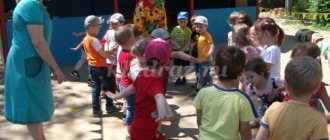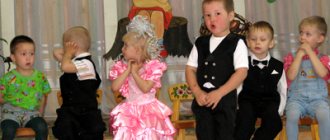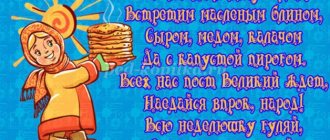Basic rules of fitness in kindergarten
Children's fitness must be divided into age groups. A number of exercises for older preschoolers are not suitable for toddlers. It is also necessary to allocate different times for studying. For example, for younger kindergarteners, training should not last more than 20-25 minutes; in the middle group, training can last half an hour, and in the older group - 35 minutes.
Classes must be conducted under the supervision of a teacher. Before training, it is necessary to check the well-being of the participants and make sure that they have changed into sportswear and shoes.
Post Views: 10,538
Types of sports elements in kindergarten
Conventionally, the sports load in kindergarten can be divided into the following categories:
- General developmental exercises in kindergarten are based on a set of developmental tasks. This may include:
- morning exercises;
- breathing practice;
- ball exercises;
- tasks for different types of motor activity with and without different objects;
- movements with a hoop.
- Health-improving exercisesAimed at improving and strengthening the body of a preschool child. Here we can highlight:
- elements for the prevention of flat feet;
- stretching exercises;
- hardening procedures, barefoot physical education;
- visiting the swimming pool;
- elements to strengthen the muscles of the back and abdomen.
- Dance and sports directionHelps to identify the child’s inclinations for one or another type of sports activity. In kindergarten you can find:
- rhythmoplasty;
- aerobics;
- gymnastics
- Play activitiesThis includes everything that helps preschoolers develop physically through play:
- football;
- basketball;
- volleyball;
- team games;
- competitive games.
It is also worth setting aside time for children to independently master sports elements. This usually happens outdoors, on a playground with slides, swings, etc., or indoors, where there is a sports corner with additional hanging equipment.
General developmental exercises in kindergarten
Depending on the goal, you can develop various sets of general developmental exercises for children of different ages. Morning exercises or physical education, breathing practice or elements with a hoop, exercises with balls or other objects. You can come up with your own program for both toddlers and older children.
Physical complex for morning exercises
The following set of exercises can be suggested as morning exercises:
- Stretch Children stand in a circle, rise on their toes and stretch upward with straight arms. With an exhalation, the arms return to the starting position through the sides, the soles of the feet fully touch the floor. You can do it on the spot, or you can take a step to the side, moving between the stretches in a circle.
- Pendulum You can also form a circle, stand with your feet shoulder-width apart, and place your hands on your waist. Do versatile head tilts.
- Doll We include the shoulders in the work. To do this, place your arms along your body. Raise your right shoulder first, then your left.
- Tumbler We sit on the floor, pull our legs towards ourselves and clasp them with our hands. From this position we do versatile rolls.
- Top We stand on our feet, placing them shoulder-width apart. We jump on two legs, alternating jumping with walking. You can alternate elements in a circular motion.
Breathing practice
It is important to teach kindergarteners to do breathing practice. It is necessary after each set of exercises. In addition, this practice is an excellent prevention of diseases of the throat and nose.
To stir up interest, you can give each element a fun name, for example:
- We blow bubbles - take a deep breath through our nose, puffing out our cheeks, then slowly exhale through our slightly open mouth.
- Pump - we stand up and put our hands on our belts, inhale and squat a little, and exhale we straighten up. The goal is to gradually make your squats lower and your inhalations and exhalations deeper.
- Chicken - we stand up and bend down, hanging our arms freely, playing the role of wings, and lowering our head. With an exhalation, we pat ourselves on the knees and say “so-so-so”, with an inhalation we straighten up and raise our arms up.
- Watch - stand up straight, feet shoulder-width apart, arms down. We swing our straight arms back and forth, while saying “tick-tock.”
- Trumpeter - sit down and fold your raised hands into a tube. While exhaling slowly we say “p-f-f”.
Movements with the ball
With the ball you can also come up with a huge number of exercises for different kindergarten groups:
- standing, we take the ball in both hands and lower them down, lifting the ball over our heads while rising on our toes;
- we transfer the ball from one straight hand to another in the starting position - standing, feet shoulder-width apart, arms to the sides, the ball is in one of the hands;
- we sit on the floor, crossing our legs, placing the ball on the right side of the floor, rolling the ball in front of us in the other direction;
- we jump on two legs with a ball in our hands;
- we throw the ball up, throw it from one hand to the other.
A complex of different elements with and without objects
- With cubes
- We stand with feet shoulder-width apart, arms along the body, cubes in hands. We raise our arms up from the sides and knock the cubes against each other.
- We sit on the floor, take the cubes in our hands and bend them at the elbows. Raise your legs up and hit the cubes under your knees.
- We jump with cubes, spreading our arms in different directions.
- With checkboxes
- We stand up, spread our arms with flags to the sides. We make lunges, touching the hand with the flag to the knee of the same leg.
- We spread our legs wide, stretch our arms forward with the flags. We turn to one side, moving our hand back and following the flag with our eyes. Repeat with the other hand.
- The starting position is the same, we raise our hands with flags up. We bend down, the flags stretch to the floor.
- No items
- Feet shoulder-width apart, arms along the body. We rise on our toes, raising our right arm up. Repeat with the other hand.
- We squat down and hug our knees with our hands. We straighten up, standing on our tiptoes and raising our arms up.
- We lie on the floor on our backs with straight legs and arms located along the body. We clasp our head with our hands and press it to our knees pulled up to our stomach. We curl up into a ball in this way.
Movements with a hoop
A hoop can also diversify children's fitness, adding interest and benefit to exercise:
- We stand up and hold the hoop below. Raise the hoop forward, then up, then forward and down again.
- Feet shoulder-width apart, clasp the hoop on the sides and press it to the chest. We turn the body in one direction, extend straight arms in the same direction. Repeat on the other side.
- The starting position is the same. We squat, bringing the hoop forward.
- Keep the hoop down. We lift it forward and bend over, looking into the hoop. We linger for a few seconds in this position. The back is straight.
- We stand near the hoop. We begin to jump around the inventory.
Wellness practice
Health-improving exercises play a huge role in fitness for preschoolers. After all, the groundwork for the rest of your life is laid precisely from childhood. Particular attention here should be paid to exercises that prevent the development of flat feet, stretching and strengthening elements.
Elements that prevent flat feet
The foot is the foundation of the entire body, so flat feet should not be taken lightly. And if we take into account that the formation of the musculoskeletal system occurs over a period of up to 6 years, then it is recommended to prevent flat feet at this age.
We offer the following set of exercises aimed at preventing flat feet:
- We sit on a chair, place a massage ball under one foot and roll it back and forth and in a circle. Repeat with the other leg. The back is straight.
- We squat in a frog pose, hands on knees, heels together:
- we press our hands on our knees and connect them together;
- we rest our hands on the floor behind our backs and, sliding the outside of our feet, bend and straighten our legs;
- Raise your legs and start tapping your feet.
- We sit on a chair with a straight back, holding its edge with our hands:
- We place our feet one by one on the heels;
- we walk on our toes back and forth;
- we take a handkerchief and try to grab it with one foot;
- transfer the scarf from one foot to the other.
- The starting position is the same. Hands on the belt. Draw a circle on the floor with the toe of one foot. Repeat with the other leg.
- We sit on the floor, arms supported behind us, legs bent, feet together, back straight. We raise our legs and press our feet into each other.
- The starting position is the same. We alternately draw pictures in the air with our toes.
Important! The entire complex is carried out without shoes, additionally providing hardening.
Stretching in kindergarten
Stretching is designed to gently stretch the muscles. In order for the elements to be performed smoothly, without jerks, calm music is used in kindergarten.
The training complex can include the following stretching elements:
- we stand up, arms along the body, toes in different directions, heels next to each other - we rise onto our toes with straight arms, stretching upward as much as possible;
- the starting position is the same - when lifting, we stretch our arms in different directions, fixing ourselves in this position;
- feet parallel, legs at shoulder level - raise our arms and sit down without lifting our feet from the floor;
- lie on the floor on your stomach, clasp your ankles with your hands, raise your head and raise your shoulders and chest, if possible, raise your stomach;
- the starting position is the same, arms along the body, legs straight - bend one leg, leaving the foot on the floor, repeat with the other leg.
Elements for strengthening the muscles of the back and abdomen
You can strengthen your core muscles in kindergarten using exercise equipment such as a horizontal bar, fitball, health discs, expanders, and abdominal benches.
The following elements perform well:
- hanging on the horizontal bar - stretches the back, simultaneously strengthening it;
- pull-ups on the horizontal bar and hanging leg raises;
- passing a fitball while lying on your back from your arms to your legs and vice versa;
- crunches on a fitball or abdominal bench;
- gluteal bridge on a fitball and so on.
And if a wall bars with attachments are installed in the kindergarten, then there should be no problems with strengthening training at all. Preschoolers themselves will find activities to their liking, using the hanging equipment to their advantage.
Dance and sports direction
This is probably the most interesting area of fitness in kindergarten. Thus, the following types of activities can be distinguished:
- Aerobics Includes all aerobic elements that fill the body with oxygen. Dancing movements, jumping, running - all these cyclical movements stimulate the functioning of the cardiac and respiratory systems and give a great mood.
- Rhythmic gymnastics A variation of the usual gymnastics, but with an emphasis on intense motor activity. A wide range of movements helps improve coordination abilities and motor memory.
- Logorhythmics A very interesting direction that combines physical elements with the pronunciation of sounds and their derivatives. Here, in addition to physical development, speech development occurs.
- Animal aerobics Another type of activity, fun and entertaining, combines aerobics with movements that imitate the behavior of animals.
- Step aerobics Rhythmic movements to lively music on step platforms. This is where fine motor skills, balance and physical strength are developed.



